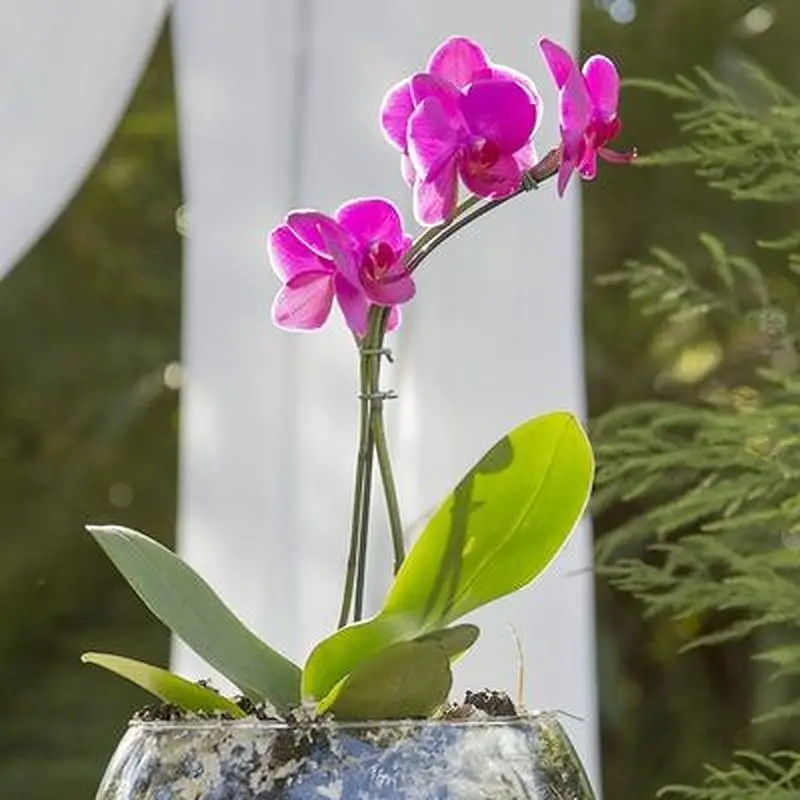
Is growing orchids in water culture possible? The answer is yes. Orchids can grow without soil, but the roots need a moist environment to thrive.
Orchids are one of the most beautiful flowers in the world, and they can be grown in a variety of ways.
Growing Orchids In Water Culture
In this blog post, we will discuss how to grow orchids in water culture.
Water culture is a great method for those who want to enjoy orchids without having to worry about soil and fertilization.
We will also talk about some of the pitfalls and benefits of growing orchids in water culture.
Can Orchids Grow Without Soil?
Water culture can be an ideal way to grow orchids especially if they are epiphytes.
They thrive in humid conditions and they often don’t do well in some soil mixes.
Although epiphytic orchids are often found growing on trees they are not parasitic.
They have specialized roots called aerial roots which are able to absorb nutrients and water from the air.
Terrestrial orchids don’t do as well in this method because they don’t have aerial roots but have more traditional plant roots.
What Is Water Culture?
The term water culture can be a bit misleading. You will often hear terms like full water culture and semi water culture.
The biggest misconception about water culture is that plants are always in water but that is not how it works, All water culture methods actually have a drying out period too.
In addition, the term semi water culture can refer to two different methods. Some people use the term semi water culture to refer to using hydroton also called LECA pebbles in the container too.
This is also called Semi Hydroponics and I will cover it in another article.
Semi And Full Water Culture What’s The Difference?
Generally, the difference between semi and full water culture refers to how much water is used and how long the roots remain in water before being allowed to dry.
Full Water Culture
For full water culture, the container only has a couple of inches of water in it and only the very bottom 1/3 of the roots are covered.
As the water evaporates it will produce high humidity levels for the other roots.
You will leave the roots in water for 5 days. Then you drain it out and let the roots sit for 2 days before adding more water.
Semi Water Culture
For semi water culture 2/3 of the roots will be in the water for 2 days after that you pour out the water and the roots will sit for 5 days before you refill your container.
What Containers Are Used For Water Culture
The number one criterion for choosing a container for water culture is that it is clear. You need to see the roots and the water level.
It can be plastic or glass and should narrow at the top to slow evaporation. Many cut flower vases work well for this
Tips For Growing Orchids In Water Culture
It’s important to know that water culture is not always successful so don’t try this with your favorite orchid unless you can stand losing it.
However, there are several things you can do to increase your chances of success.
Use Ony Epiphytic Orchids For Water Culture
First, you need to make sure your orchid is an epiphytic orchid. This method does not really work for terrestrial orchids.
Water Quality
When it comes to water culture, not all water is the same. It can have too high a pH or have harmful chemicals in it.
Since your orchids are growing in water it is important they get water that is slightly acidic because that is what they do best in.
You can use rainwater or distilled or RO water for them if your tap water is not good.
You need to know the pH of your water. It should be between 5.5 and 6.5. Some municipal water can be as high as 8.0 to almost 9.0 pH.
Start With A New Nursery Plant
It is best to try water culture with a new nursery plant. Plants that were previously potted for a long time can be harder to switch over.
Clean Roots Are A Must
Any orchid you attempt water culture with must have clean roots.
Otherwise, any remaining sphagnum moss or bark will rot in the water and you don’t want this to happen. This can lead to root rot.
So gently clean anything left from a previous potting off. You might need to soak your roots for a while to get all of it off.
Give It Time To Adapt
Expect your orchid to be in shock when you first try water culture because it needs time to adapt to its new environment.
It may look limp and unhappy and that’s because it is. It can take a month or more to fully adapt. Orchids are slow-growing plants.
Don’t panic and try to repot it into a different medium. This will just add additional stress to your orchid.
Eventually, it will perk up and grow even better than it was before.
So if you are interested in growing orchids, water culture is a great option.
Below is a video that will give you the ins and outs of water culture. This gal really knows her stuff too.
Benefits Of Water Culture
Generally, water culture is a great way to grow epiphytic orchids. It makes it easy to control the environment.
One of the great things about water culture is that it is very easy to fertilize orchids.
You can simply add a small amount of fertilizer to the water every week or two.
This is a great way to make sure that your orchids are getting the nutrients they need without having to worry about soil.
Another benefit of water culture is that it is very easy to control the amount of water your orchids are getting.
This is a great way to prevent root rot, which can be a problem with other methods of growing orchids.
You can also control the temperature of the water, which is important for some types of orchids.
Fertilizing Water Culture Orchids
There are as many different ways to fertilize water culture orchids as there are different orchid growers.
Some actually spray it on the roots at the end of the dry cycle.
Still, others allow the roots to soak in fertilizer for a few hours before replacing it with fresh water.
But the one thing everybody seems to agree on is less is more. So water culture orchids need a very dilute mixture. Maybe 1/4 stregnth.
If you dilute it properly just about any balanced plant fertilizer will work. Just avoid products with urea as a primary nitrogen source.
If you are using distilled or RO water adding a CalMag supplement is beneficial to replace these lost elements.
Orchids also do well with kelp supplements. These add many beneficial plant hormones and trace elements. It is also a source of potassium.
Orchids need to be fed regularly. Growers suggest using a “balanced” fertilizer such as 20-20-20 that includes all “necessary trace elements.”
Regardless of the fertilizer formulation you choose to use, it should contain little or no urea. If you are unsure of what fertilizer to use, you can generally use any fertilizer you would for your other container plants.
Orchids will do far better with too little fertilizer than with too much. Many growers recommend the “weakly, weekly” approach, applying a dilute (1/4 strength) fertilizer each time they water, rather than applying a full dose once a month.
Also, it is best not to fertilize a completely dry plant as the fertilizer can burn the dry roots. Water first then follow with fertilizer solution.
https://www.aos.org/orchids/orchid-care/how-do-i-feed-my-orchid.aspx?
Growing In Water Culture Final Thoughts
If you follow these tips, you should have no problem growing beautiful orchids in water culture.
This is a great way to enjoy these stunning flowers without having to worry about soil and fertilization. Give it a try today!
Here is another article you might like: Growing Orchids In Hydroponics – Hydroponic Orchids
Here is some more scientific information about orchids Orchidaceae – Wikipedia
This post contains affiliate links.


